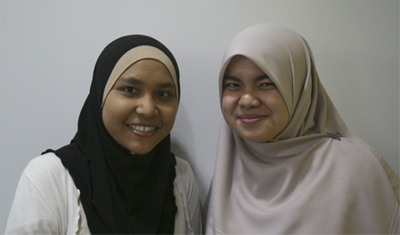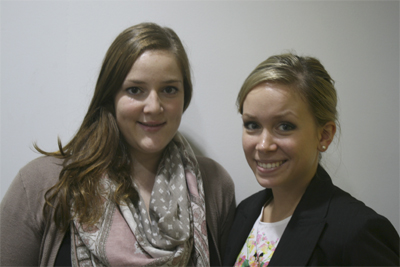While walking around campus, UOS students may have encountered quite a few international students with different appearances, languages and cultures. In order to have a better understanding of their cultures and to learn about their campus lives at the University of Seoul (UOS), The UOS Times interviewed students from the other side of the world. Isabel Brendenahl (22, Department of Internatonal Realations) and Laura Lunes (22, Department of Internatonal Realations) are from the University of Mannheim in Germany. Itie Lolen (22, Department of English Language and Literature) and Nadiah Husna Zain (22, Department of English Language and Literature) are from the University of Malaya in Malaysia. They are ready to share their stories.
Welcome to the UOS, Korea!
To the question of why they chose Korea, Itie and Nadiah answered, “We were already familiar with Korean culture because back in Malaysia, Korean soap operas, music and movies are very popular. The University of Malaya offered exchange student programs with three different choices: Taiwan, Singapore and Korea. We chose Korea to get to know what Korean culture is actually like.” However, things were different for Isabel and Laura. Coming to Korea was not their first choice. “I first wanted to go to the U.S., but our school offered exchange student spots at the UOS instead. I did not know much about Korea compared to China and Japan, the nations frequently mentioned in the international news. So I started to research about Korea and I thought Korea would be an interesting place to have my exchange student experience,” said Isabel.

It had been three weeks since they came to Korea, and so far they love their living at the UOS. Nadiah said, “Buildings and facilities are more advanced here than in Malaysia.” Itie added that she loves the eco-friendly surroundings of the UOS. “Back in Malaysia, our school is located in the center of city so there are no plants. I think UOS campus is very pretty.” Isabel and Laura seemed very satisfied with their choice to come to Korea. Isabel described her life at the UOS as living in a huge theme park. “Everything you see is something new. It feels like I can do something new every day and it seems like it will never stop. I am already planning to come back to Korea,” Laura said.
Two Biggest Obstacles
However, the language barrier and the lack of cultural understanding are the two biggest difficulties. Isabel got sick in the first week of school and she had trouble explaining her symptoms to others. Itie experienced a similar situation. She asked for help at the print shop, but nobody understood her. Though they took Korean language classes, they are beginners and very few Korean students can communicate well in English. Itie said, “The language barrier is so far the biggest difficulty that I am going through right now. English is my second language. In Malaysia, half of our daily lives is in English, the other half is in Malaya, our mother tongue.”
The lack of understanding about different cultures is another problem. Ities and Nadiah pray five times a day and wear hijabs. They neither eat pork nor any type of processed meat. These cultural differences sometimes breed misunderstandings and conflicts. They said, “Many Koreans are narrow-minded towards Muslims. They always stare at us in a strange way and it sometimes feels uncomfortable. Since it was hard for us to find food cooked without meat on campus, we had to eat instant ramen noodles the whole first week.”
Embracing the Difference : A Way to Cultural Diversity
However, these four international students all said they appreciate UOS students’ willingness to help foreign exchange students. Isabel and Laura were deeply impressed by UOS students who guided them to campus IT office when Isabel once asked how they can register Wifi in their laptops. “When you actually get to know Koreans, almost all of them are very nice and helpful. In Europe, many people normally do not give much effort to help. However, Koreans are sincerely trying to help us. I think that their willingness and kindness make up for obstacles such as the language barrier.”

Nadiah and Itie pointed out that UOS students lack exposure to diverse cultures and traditions. “40 percent of students in the University of Malaya are foreigners from all over the world. So I am used to being exposed to these various cultures. Cultural diversity is not only about food and people but also about religion.” Isabel recalled her experience in Hongdae. “In Europe, it is okay to start talking to people, even to strangers. But in Korea, people normally do not talk to strangers. At first, I did not understand why some Koreans were embarrassed when I started talking to them. But I now understand and respect this difference because it is also a part of the Korean culture.” According to them, a way towards greater cultural diversity at the UOS is simple. All it takes is to understand, respect and embrace these cultural differences.
I always wondered how international students think about Korea, especially about the UOS. From their stories, I found there are both good and bad impressions. However, their overall impression of the UOS is very positive and they love being here in Korea. Laura said, “I think the key point to understand cultural diversity is communication. I am experiencing Korean culture everyday by trying different foods, talking to new people and exploring every street and city. If anyone wants to know anything about Germany, please do not hesitate to come and talk to us. We are nice people.”
Choi Ji-in Reporter
jiin9110@uos.ac.kr
All photos credited by Choi Ji-In

